Pythons are a large and diverse group of snakes, ranging significantly in color, size, habitat, diet, and more. Among them are some of the largest snakes in the world, as well as many of the most popular snakes in the exotic pet trade! But what exactly makes a snake a python? Furthermore, what kind of traits do these stunning serpents share, and how many different types of pythons are there?
Read on as we explore the many different python families, genera, and species and what makes them so unique below.
What is a Python?
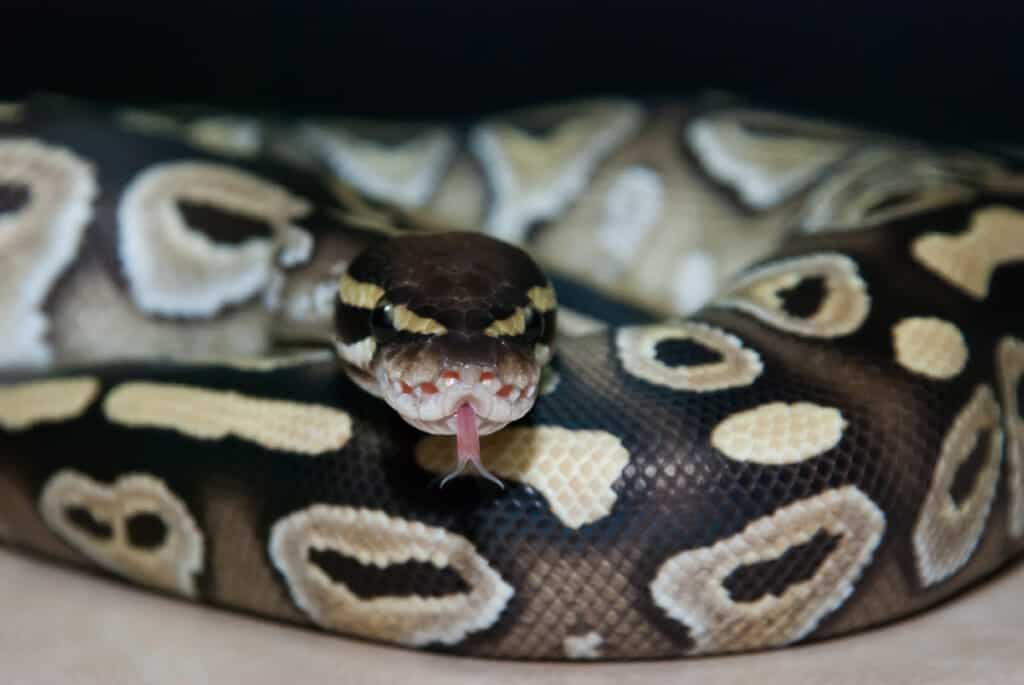
, better known as the ball python, is one of the most popular pet snakes in the world!
©iStock.com/LWOPhotography
To put it as concisely as possible, a python is any species of snake belonging to the Pythonidae family of snakes. Today, there are more than 20 different families of snakes, and Pythonidae is roughly right in the middle as far as its overall size, with it containing 42 different species of pythons that are divided into 10 different genera.
Of course, we classify animals into groups like families and genera based on the particular traits they share, so it will help to first understand what traits actually make a snake a python!
Snakes within the Pythonidae family, pythons, share the following characteristics:
- Pythons are non-venomous. Fortunately, they don’t need venom to take down their next meal.
- Pythons kill their prey via ambush and constriction. Many species are able to camouflage themselves and wait silently for prey to wander towards them. Pythons strike quickly, rapidly coiling their bodies around and suffocating their prey within mere minutes. The prey is then typically swallowed whole and slowly digested.
- Pythons also use their unique teeth to grasp their prey. Their teeth are somewhat short, very narrow, and pointed and curve backward to sort of “lock” their prey in their mouths. Most pythons have four rows of these teeth on their upper jaw and two rows on the bottom.
- Pythons are oviparous. They lay oval-shaped, leathery-shelled eggs which must be incubated for a period of time before they hatch.
Next, let’s take a look at the many different groups and specific types of pythons within this impressively large family of snakes!
Python: The “True” Pythons
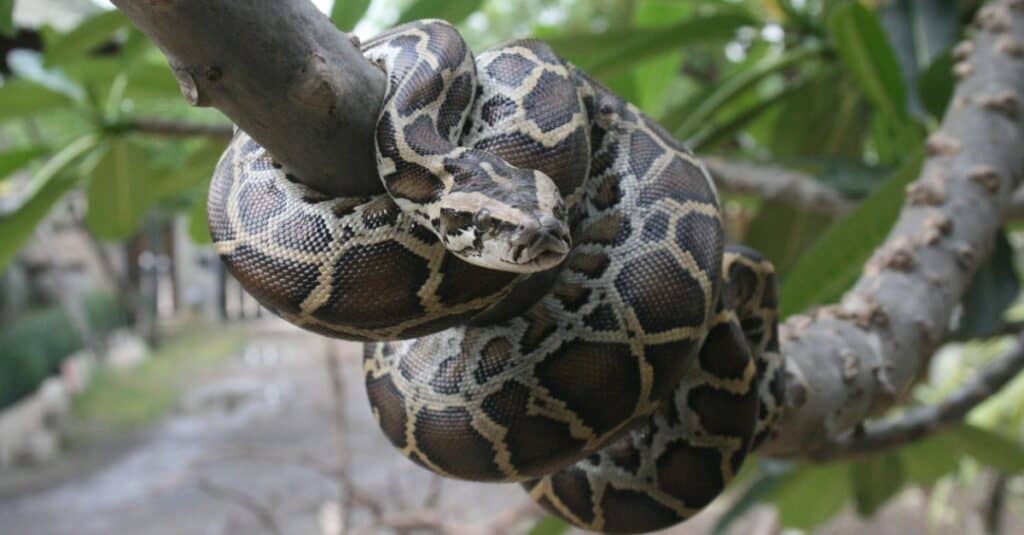
Burmese
pythons are part of the
Pythongenus, the largest group within the
Pythonidaefamily.
©iStock.com/Lunatic_67
The first group of pythons we’ll cover here is the Python genus, or the “true” pythons. This is the largest genus within the Pythonidae family, spanning 10 total living species! This is also one of the very first genera suggested for the classification of python snakes as we know them today, or, as they were described in 1803, “non-venomous, flecked snakes.”
Additionally, these particular pythons are primarily native to tropical regions throughout Asia and Africa. They like it warm and humid and generally reside in dense forests.
Notably, this group includes several popular species within the exotic pet trade, such as the ball python and the Burmese python. It also includes an extinct species, the European python.
This genus contains 11 species:
- Indian python, Python molurus
- Central African rock python, Python sebae
- Ball python, Python regius
- Burmese python, Python bivittatus
- Southern African rock python, Python natalensis
- Sumatran short-tailed python, Python curtus
- Borneo python, Python breitensteini
- Angolan python, Python anchietae
- Brongersma’s short-tailed python, Python brongersmai
- Myanmar short-tailed python, Python kyaiktiyo
- European python, Python europaeus (Extinct)
Morelia: The Tree Pythons
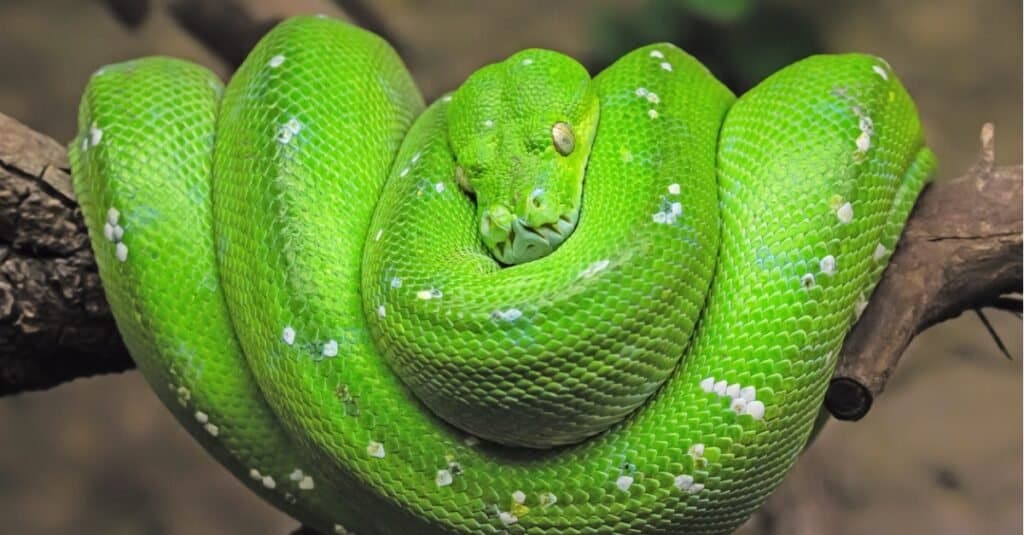
The handsome green tree python belongs to the Morelia genus of pythons, all of which are highly arboreal.
©iStock.com/tane-mahuta
The second-largest genus within the Pythonidae family is Morelia, more commonly known as the tree pythons. There are currently six species (with seven subspecies) in this genus.
As their common name suggests, they are highly arboreal, spending much of their time slithering about the canopies of hot, humid forests. These snakes are primarily found in Australia, Indonesia, and New Guinea.
Notably, most tree python species are impressively long! Consider the carpet python, for example, which commonly grows to anywhere from 6 to 13 feet in length. Additionally, despite their arboreal nature, tree pythons can also be surprisingly bulky and heavy. Depending on the species, they can weigh anywhere from just four or five pounds to well over 30 pounds.
This genus contains six species:
- Green python, Morelia azurea
- Bredl’s python, Morelia bredli (Other common names: Centralian python, central Australian carpet python)
- Rough-scaled python, Morelia carinata
- Southwestern carpet python, Morelia imbricata
- Carpet python, Morelia spilota
- Green tree python, Morelia viridis
Simalia: The Amethystine Pythons
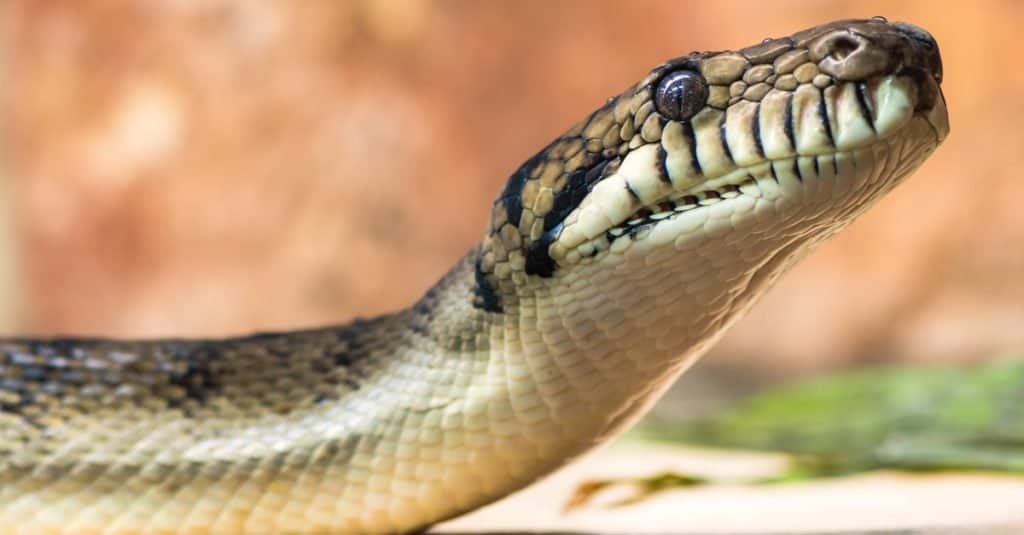
Despite their massive size, Amethystine pythons are excellent swimmers.
©IanRedding/Shutterstock.com
Next up is the third-largest genus in the Pythonidae family: Simalia, better known simply as the Amethystine python group or complex. There are six species and no subspecies in this genus, and all six species live primarily in Indonesia, New Guinea, and Australia.
Strangely, these stunning snakes tend to have an iridescent sheen to their scales, giving them a shimmering appearance. Most species are also quite colorful, ranging from yellows and browns to reds and greens.
They also are among the longest and heaviest snakes in Australia and Indonesia, growing to be anywhere from 6 to 15+ feet long and ranging from 10 to 60+ pounds, depending on the species. Simalia amethistina, in particular, is especially large and bulky, capable of reaching more than 18 feet long and weighing more than 75 pounds.
This genus contains six species:
- Amethystine python, Simalia amethistina
- Boelen’s python, Simalia boeleni (Also known as the black python)
- Moluccan python, Simalia clastolepis (Also known as the yellow python)
- Australian scrub python, Simalia kinghorni
- Tanimbar python, Simalia nauta
- Halmahera python, Simalia tracyae
Antaresia: The Children’s Pythons
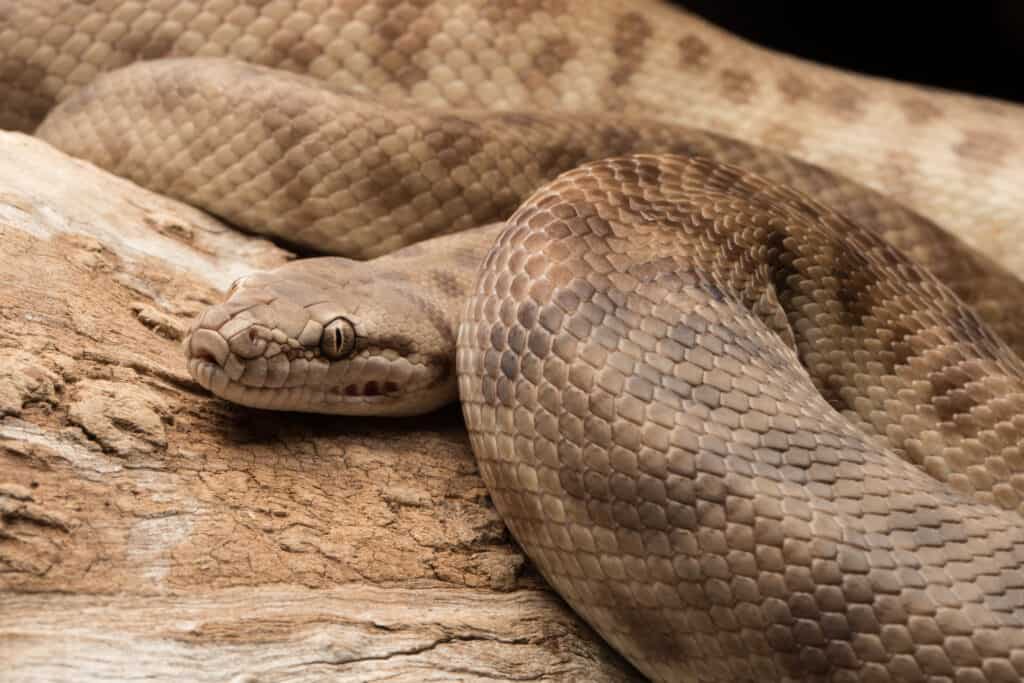
Children’s pythons are among the smallest snakes in the Pythonidae family.
©LIGHTITUP/Shutterstock.com
Antaresia is another notable genus within the Pythonidae family. It contains four species and two subspecies. This type of python, most commonly known collectively as children’s python, is named after John George Children. Children was the British Museum’s curator at the time the first species (also known as a type species) for the genus was discovered and documented.
Interestingly, this genus contains Pythonidae’s smallest snakes! Generally, children’s pythons are all fairly small, usually measuring just 1 to 3 feet in length. The smallest species, appropriately named the pygmy python, usually grows to only around 20 inches long.
This genus contains four species:
- Children’s python, Antaresia childreni
- Spotted python, Antaresia maculosa (Other common names: eastern children’s python, eastern small-blotched python)
- Pygmy python, Antaresia perthensis
- Stimson’s python, Antaresia stimsoni
Liasis: The Water Pythons

Olive pythons,
Liasis olivaceus, are highly aquatic and prefer habitats close to large bodies of water.
©Ken Griffiths/Shutterstock.com
The Liasis genus of pythons are primarily known for their semi-aquatic nature. They are commonly known simply as water pythons, and the genus contains three total species and five subspecies.
Pythons within the Liasis genus prefer warm, humid, low-lying habitats close to large bodies of water. They commonly camouflage themselves and lie in wait to strike their water-dwelling prey like various fishes, frogs, and toads as well as nearby rodents and birds.
Geographically, these snakes also share a similar range–namely southern Indonesia, eastern New Guinea, and northern and western Australia. In terms of size, they are quite large, ranging from around 7 to 10 feet in length. Notably, the olive python is the largest and most aquatic in nature of the group.
This genus contains three species:
- Water python, Liasis fuscus
- Macklot’s python, Liasis mackloti
- Olive python, Liasis olivaceus
Malayopython: The Reticulated Pythons
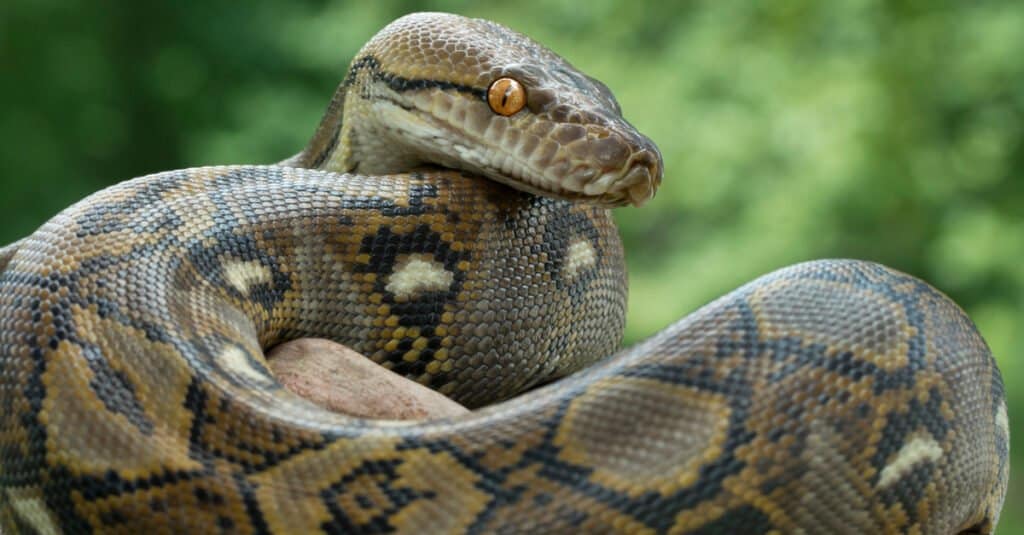
The reticulated python,
Malayopython reticulatus, is one of the heaviest snakes in the world.
©Mark_Kostich/Shutterstock.com
Next up is the Malayopython genus, which consists of just two species and three subspecies. Both species share a similar geographic range spanning much of India and Southeast Asia.
Originally part of the aforementioned Python genus, two species, the reticulated python and the timor python, were later placed into their own genus, Malayopython, in 1975. They gained this distinct classification due to their uniquely-shaped “pits” around their mouths and nostrils.
Both the reticulated and timor types of pythons are quite long and large. However, the reticulated python is especially impressive, with many individuals reaching up to 20 feet long and weighing more than 150 pounds. It’s actually one of the heaviest snakes on the planet!
This genus contains two species:
- Reticulated python, Malayopython reticulatus
- Timor python, Malayopython timoriensis
Even More Types of Pythons…
Although we’ve already covered the largest, most notable genera and specific types of pythons within the Pythonidae family, there are actually a few more than what we’ve covered here!
In fact, there are still four other genera in this group, and they currently collectively contain an additional seven species of pythons. Two of them only contain a single species!
The four remaining genera in the Pythonidae family are:
- Apodora, 1 species, the Papuan olive python (Apodora papuana)
- Aspidites, 2 species, shield pythons (Aspidites melanocephalus and ramsayi)
- Bothrochilus, 1 species, the Bismarck ringed python (Bothrochilus boa)
- Leiopython, 3 species, white-lipped pythons (Leiopython albertisii, fredparkeri, and biakensis)
Summary of Types of Pythons
| Types of Pythons (Pythonidae) | Common Species | |
|---|---|---|
| 1 | Python (“True” Pythons) | Indian Python, Central African Rock Python, Ball Python, Burmese Python, South African Rock Python, Sumatran Short-Tailed Python, Borneo Python, Angolan Python, Brongersma’s Short-Tailed Python, Myanmar Short-Tailed Python, European Python (extinct) |
| 2 | Morelia (Tree Pythons) | Green Python, Bredl’s Python, Rough-Scaled Python, Southwestern Carpet Python, Carpet Python, Green Tree Python |
| 3 | Simalia (Amethystine Pythons) | Amethystine Python, Boelen’s Python, Moluccan Python, Australian Scrub Python, Tanimbar Python, Halmahera Python |
| 4 | Antaresia (Children’s Pythons) | Children’s Python, Spotted Python, Pygmy Python, Stimson’s Python |
| 5 | Liasis (Water Pythons) | Water Python, Macklot’s Python, Olive Python |
| 6 | Malayopython (Reticulated Pythons) | Reticulated Python, Timor Python |
| 7 | Apodora | Papuan Olive Python (Apodora papuana) |
| 8 | Aspidites (Shield Pythons) | Aspidites melanocephalus, Aspidites ramsayi |
| 9 | Bothrochilus | Bismarck Ringed Python (Bothrochilus boa) |
| 10 | Leiopython (White-Lipped Pythons) | Leiopython albertisii, Leiopython fredparkeri, Leiopython biakensis |
The photo featured at the top of this post is © Mark_Kostich/Shutterstock.com
Discover the "Monster" Snake 5X Bigger than an Anaconda
Every day A-Z Animals sends out some of the most incredible facts in the world from our free newsletter. Want to discover the 10 most beautiful snakes in the world, a "snake island" where you're never more than 3 feet from danger, or a "monster" snake 5X larger than an anaconda? Then sign up right now and you'll start receiving our daily newsletter absolutely free.
Thank you for reading! Have some feedback for us? Contact the AZ Animals editorial team.






